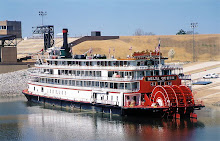
This is the steam packet boat ELIZABETH at Fredericktown in 1902. She was 188 feet x 35 x 5.5 and was built at Brownsville ( the hull was built at Belle Vernon ) in 1888 for the Pittsburgh - Elizabeth Pa. trade. This trade died out by 1900, no doubt because the railroad by that time went as far upriver as Brownsville. It would be 7 more years till the rails reached any farther south on the west bank. This made the Ten Mile Creek Country trade above Brownsville worth pursuing. In 1902 an independent line was formed called the Monongahela River Packet Company and ran the ELIZABETH under that flag as far upriver as Morgantown. This put her in competition with boats of the Pittsburgh Brownsville and Geneva Packet Company , the oldest and biggest company on the upper river.
In August of 1902 she and the rival company's Str. I. C. WOODWARD met below old lock # 9 and raced each other to the chamber to be the first to lock through. They must have been pretty evenly matched because they arrived at the same time , both becoming wedged in the mouth of the lock and neither could or would move for the other. Here they sat for a while until the Masters of the vessels were called and the issue resolved .

The race resulted in a tie
Which won the race is unknown but in the end the smaller company lost out to the bigger in the trade. 1902 saw the end of the Monongahela River Packet company. She was laid up later that year and in 1903 was sold and moored in the Allegheny river above Pittsburgh's 6th street bridge. In 1904 the boat next to her , the OLIVETTE , caught fire setting the ELIZABETH ablaze. She was turned loose, drifted under the Union bridge , a covered wooden structure and set it on fire . She was then pushed to the bank "where she burned at leisure".
Fire was a big enemy of these large wooden structures, dried wood, countless coats of flammable paint ( anyone who has ever worked on any riverboat, of wood or steel, can tell you that the paint is applied at every opportunity ) , kerosene lamps ( until the 1890's ) , coal or coal oil stoves, strong winds often present on the river, all made it a real possibility. Most cities had large wharf front fires at different times that would destroy many boats at once. Other very real dangers were snags ( sunken trees poking into the hull, causing some boats to sink in less than a minute ) and other sunken obstructions, boiler explosions, groundings and Pilot errors. Most all were heavily insured so when for instance, the Str. NEW ERA was sunk then usually out came the NEW ERA # 2 in a few months. Even if a boat was lost due to fire, boiler explosion or sinking, the steam engine would always be salvaged. They seem to have been virtually indestructible and were often used in several different boats over many years. Some boats lasted 20 years and many just a few years. Packet boats ran year round and tended to wear out quicker than the bigger line haul towboats which ran somewhat seasonally.
Here's the ELIZABETH at Brownsville rounding to with her stacks knocked back to clear the wooden covered bridge there. On the left descending bank is the Str. EDGAR CHERRY, a packet that ran for several years between Pittsburgh and Morgantown until she hit the gates at old lock # 4 and sunk in 1904. One can see the front end of a packet boat on the Brownsville (left) side, this is the OLIVETTE, the boat that would two years later cause the fiery destruction of the Elizabeth in Pittsburgh ( see above ) .

Here she is in the 1890's, possibly at McKeesport, Pa. It must have been some kind of holiday.

Another boat running in this trade for the Mon River Packet Company was the Str. GERTRUDE. She was fancier than most Mon River packets, with a huge pilot house not often seen up here. She was built at Hawesville Ky. in 1895 and ran on the lower Ohio before she came to the Monongahela River in 1902. Before going into the trade she was given new floors and staterooms were added. She was also given a Texas ( small deck of cabins under the Pilot house ) so likely the pilot house was altered then. The big stage seen here was likely left off as they were not much used on the Monongahela. With our steep banks a plank seems to have been sufficient for most landings, and many of the towns had stone or brick wharfs or small floating wharfboats for packets to land on. In 1903 GERTRUDE too, was sold and later ran on the Chattahoochie River in Georgia.

Str. GERTRUDE on lower Ohio 1900.
Information for this was taken mostly from Ways Packet Directory, 1848 - 1994 by Fred Way Jr. Some images are from a great site about the Elizabeth Marine Ways that includes much detail about many Mon river and Mon river built boats, Steamboat Building in Elizabeth, PA . This wonderful site is maintained by Jay W. Mohney and his efforts are a priceless addition to river knowledge.



























No comments:
Post a Comment